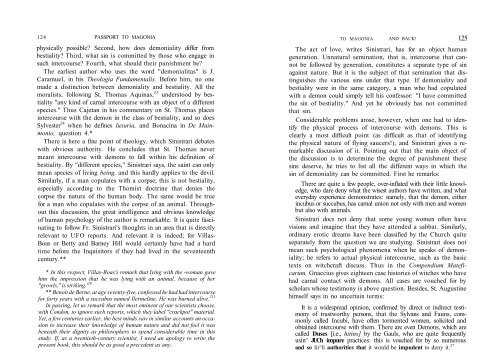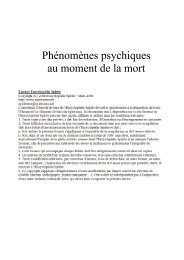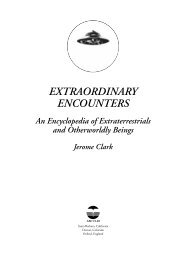Create successful ePaper yourself
Turn your PDF publications into a flip-book with our unique Google optimized e-Paper software.
124 PASSPORT TO MAGONIA<br />
physically possible? Second, how does demoniality differ from<br />
bestiality? Third, what sin is committed by those who engage in<br />
such intercourse? Fourth, what should their punishment be?<br />
The earliest author who uses the word "demonialitas" is J.<br />
Caramuel, in his Theologia Fundamentalis. Before him, no one<br />
made a distinction between demoniality and bestiality. All the<br />
moralists, following St. Thomas Aquinas, 23 understood by bestiality<br />
"any kind of carnal intercourse with an object of a different<br />
species." Thus Cajetan in his commentary on St. Thomas places<br />
intercourse with the demon in the class of bestiality, and so does<br />
Sylvester 24 when he defines luxuria, and Bonacina in De Mainmonio,<br />
question 4.*<br />
There is here a fine point of theology, which Sinistrari debates<br />
with obvious authority. He concludes that St. Thomas never<br />
meant intercourse with demons to fall within his definition of<br />
bestiality. By "different species," Sinistrari says, the saint can only<br />
mean species of living being, and this hardly applies to the devil.<br />
Similarly, if a man copulates with a corpse, this is not bestiality,<br />
especially according to the Thomist doctrine that denies the<br />
corpse the nature of the human body. The same would be true<br />
for a man who copulates with the corpse of an animal. Throughout<br />
this discussion, the great intelligence and obvious knowledge<br />
of human psychology of the author is remarkable. It is quite fascinating<br />
to follow Fr. Sinistrari's thoughts in an area that is directly<br />
relevant to UFO reports. And relevant it is indeed; for Villas-<br />
Boas or Betty and Barney Hill would certainly have had a hard<br />
time before the Inquisitors if they had lived in the seventeenth<br />
century.**<br />
* In this respect, Villas-Boas's remark that lying with the -woman gave<br />
him the impression that he was lying with an animal, because of her<br />
"growls," is striking.' 26<br />
** Benoit de Berne, at age seventy-five, confessed he had had intercourse<br />
for forty years with a succubus named Ilermeline. He was burned alive. 211<br />
In passing, let us remark that the most eminent of our scientists choose,<br />
with Condon, to ignore such reports, which they label "crackpot" material.<br />
Yet, a few centuries earlier, the best minds saw in similar accounts an occasion<br />
to increase their knowledge of human nature and did not feel it was<br />
beneath their dignity as philosophers to spend considerable time in this<br />
study. If, as a twentieth-century scientist, I need an apology to write the<br />
present book, this should be as good a precedent as any.<br />
TO MAGONIA AND BACK! 125<br />
The act of love, writes Sinistrari, has for an object human<br />
generation. Unnatural semination, that is, intercourse that cannot<br />
be followed by generation, constitutes a separate type of sin<br />
against nature. But it is the subject of that semination that distinguishes<br />
the various sins under that type. If demoniality and<br />
bestiality were in the same category, a man who had copulated<br />
with a demon could simply tell his confessor: "I have committed<br />
the sin of bestiality." And yet he obviously has not committed<br />
that sin.<br />
Considerable problems arose, however, when one had to identify<br />
the physical process of intercourse with demons. This is<br />
clearly a most difficult point (as difficult as that of identifying<br />
the physical nature of flying saucers!), and Sinistrari gives a remarkable<br />
discussion of it. Pointing out that the main object of<br />
the discussion is to determine the degree of punishment these<br />
sins deserve, he tries to list all the different ways in which the<br />
sin of demoniality can be committed. First he remarks:<br />
There are quite a few people, over-inflated with their little knowledge,<br />
who dare deny what the wisest authors have written, and what<br />
everyday experience demonstrates: namely, that the demon, either<br />
incubus or succubus, has carnal union not only with men and women<br />
but also with animals.<br />
Sinistrari docs not deny that some young women often have<br />
visions and imagine that they have attended a sabbat. Similarly,<br />
ordinary erotic dreams have been classified by the Church quite<br />
separately from the question we are studying. Sinistrari does not<br />
mean such psychological phenomena when he speaks of demoniality;<br />
he refers to actual physical intercourse, such as the basic<br />
texts on witchcraft discuss. Thus in the Compendium Mateficarum,<br />
Gnaccius gives eighteen case histories of witches who have<br />
had carnal contact with demons. All cases are vouched for by<br />
scholars whose testimony is above question. Besides, St. Augustine<br />
himself says in no uncertain terms:<br />
It is a widespread opinion, confirmed by direct or indirect testimony<br />
of trustworthy persons, that the Sylvans and Fauns, commonly<br />
called Incubi, have often tormented women, solicited and<br />
obtained intercourse with them. There are even Demons, which are<br />
called Duses [i.e., hitins] by the Gauls, who are quite frequently<br />
usin^ JUCh impure practices: this is vouched for by so numerous<br />
and so lii^li authorities that it would be impudent to deny it. 27





